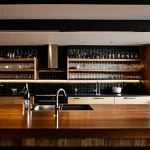Unique Layouts and Spatial Design in UK Kitchen Bars
Designing UK kitchen bar layouts requires balancing function and style within often limited space. Maximising small spaces is a priority, especially in urban homes where open-plan concepts reign supreme. A well-planned kitchen bar can seamlessly connect cooking areas with living and dining spaces, enhancing the UK kitchen flow and promoting social interaction.
Effective kitchen bar spatial planning in UK homes involves thoughtful zoning. This means creating distinct functional areas that coexist without crowding. For example, placing the kitchen bar as a divider between the kitchen and lounge can serve as both a casual dining spot and a prep area, making the space versatile.
Also to discover : Exploring the evolution of uk kitchen bars: meeting shifting consumer tastes
Open-plan layouts benefit significantly from such integration. The bar becomes a focal point, encouraging informal gatherings while maintaining an efficient workflow. Careful measurements and strategic furniture choices help maintain clear pathways, essential for smooth UK kitchen flow in compact spaces.
In sum, embracing smart UK kitchen bar layouts not only maximises space but also elevates everyday living by fostering connectivity between living, dining, and cooking zones.
Also read : Enhancing culinary magic: transformative uk kitchen design secrets
Material Choices and Quality Craftsmanship
Understanding UK kitchen materials is key to crafting a space that balances durability with style. Quartz worktops, highly popular for their strength and low maintenance, offer a sleek, modern look favored in many UK kitchens. Meanwhile, wood surfaces bring warmth and character but require attentive care to maintain their beauty. Laminate remains a budget-friendly choice, providing a variety of finishes while resisting scratches and stains.
When it comes to craftsmanship in UK kitchens, custom joinery and bespoke elements elevate the design beyond standard installations. Skilled artisans tailor cabinets and kitchen bars to fit unique layouts and personal tastes, ensuring each piece is both functional and visually striking. This bespoke approach emphasizes precise workmanship, enhancing both longevity and aesthetic appeal.
Selecting materials also involves considering wear and tear. Quartz’s resistance to heat and scratches makes it ideal for high-traffic areas, while wood’s charm suits quieter, more decorative zones. Understanding these nuances helps homeowners choose surfaces that not only complement current kitchen bar surface trends but also stand the test of time, combining beauty with resilience.
Distinctive Seating Options and Social Functionality
Seating plays a crucial role in social kitchen design, offering both style and practicality. In the UK, popular choices include kitchen bar seating, benches, and integrated banquette seating UK. Bar stools are a versatile option, ideal for creating a casual spot for quick meals or drinks while engaging with guests. Their compact design suits kitchens where space is limited but sociability remains a priority.
Integrated banquette seating UK is an excellent solution for combining comfort with space-saving benefits. These built-in benches often have storage underneath, optimizing every inch of kitchen area. They foster a cozy, intimate atmosphere perfect for family gatherings or entertaining friends.
Benches provide flexible seating for larger groups and can be tucked under tables to save space when not in use. Combining these seating types can transform a kitchen into a lively hub, inviting conversation and easy interaction. Choosing the right configuration enhances both aesthetics and functionality, making the kitchen a natural space for connection and enjoyment. This blend of adaptability and style is key to effective social kitchen design that suits modern UK homes.
Integrated Storage and Practical Features
Smart storage transforms the kitchen bar into an efficient, organized space. In the UK, kitchen bar storage solutions often include pull-out drawers and under-bar cabinets, making the most of limited room. These hidden storage solutions allow seamless access to essentials while keeping the area tidy and stylish.
Multi-functional islands are a standout feature. Serving simultaneously as prep space, dining area, and storage hub, they optimize every inch. Shelving integrated into bars or islands offers visible yet neat places for glassware and utensils, promoting easy retrieval.
Innovative organisational approaches have elevated UK kitchens. Smart kitchen storage systems incorporate customizable compartments and modular inserts tailored to individual needs. This flexibility supports diverse lifestyles, whether hosting parties or quick family meals, enhancing practicality without sacrificing style.
By combining clever design with functional elements like slide-out racks and concealed bins, these hidden storage solutions foster an uncluttered, welcoming atmosphere at the kitchen bar. Users benefit from improved accessibility and increased storage capacity—two crucial aspects when space is at a premium. Embracing these smart solutions ensures that kitchen bars remain both practical and visually appealing without overwhelming the room.
Influences on UK Kitchen Bar Style and Aesthetic
The kitchen bar design trends UK aptly blend classic British heritage with a modern flair. Traditional elements, such as oak or painted cabinetry, are often combined with sleek, minimalist finishes to create a balanced look. This fusion respects British design influences rooted in craftsmanship while embracing contemporary needs for functionality and space efficiency.
In terms of popular colour palettes, neutral tones like soft greys, muted blues, and warm beiges dominate. These palettes pair well with natural wood and stone finishes, reflecting a preference for understated elegance. Matte and satin finishes are preferred over glossy surfaces, delivering a modern yet cozy kitchen bar atmosphere.
Moreover, modern vs traditional UK kitchens show a clear influence from European and global trends. Scandinavian simplicity enhances clean lines, while Mediterranean warmth adds a touch of vibrancy. The global influence encourages the use of mixed materials such as metal accents and textured tiles, offering versatility and personality to British kitchen bars.
Understanding these overlapping influences helps homeowners achieve a stylish, functional kitchen bar design reflecting both heritage and innovation.
Comparison with Kitchen Bars Around the World
Exploring UK vs global kitchen bars reveals striking cultural and functional differences. Unlike American kitchen bars, which often focus on large islands designed for socialising and casual dining, British kitchen bars tend to maximise space efficiency and practicality, reflecting the UK’s generally more compact home layouts.
In many European countries, kitchen bars serve as multi-purpose zones. For instance, French kitchen bars often emphasize aesthetics and leisurely meals, blending culinary art with social interaction. Meanwhile, in Asian kitchen bars, especially in Japan, the design integrates minimalism and high technology, ensuring cleanliness and streamlined use—traits less common in UK kitchens.
The UK kitchen culture prioritizes adaptability. From busy morning routines to evening family gatherings, kitchen bars accommodate a range of activities. British kitchen bars frequently incorporate clever storage solutions and durable surfaces suited to the varied uses. A typical British home might prioritise a smaller footprint with modular seating, balancing function with social space.
These differences highlight how the UK lifestyle shapes kitchen bar functionality, making British kitchen bars versatile hubs rather than purely social or culinary spaces. This adaptability sets the UK apart in international kitchen comparisons.

